Boone County was established in 1869, with land from parts of Carroll and Marion counties. The county’s name has usually been interpreted as a salute to pioneer Daniel Boone, but some evidence suggests that early settlers believed the area’s beauty to have been a “boon” or gift to them, hence, the name.
The county lies entirely within the Ozark Mountains. Isolated peaks of the Boston Mountain range are found in the south, including Boat Mountain, Pilot’s Knob, and Gaither Mountain
As of the latest census (2020), there are 37,373 residing in the county. The county spans 602 square miles and borders Missouri to the north.
Portions of Bull Shoals Lake and Table Rock Lake lie in the northeast and northwest corners, respectively. The county has 2 cities and 9 towns, along with 26 unincorporated communities and townships.
Boone County has a fascinating history to explore from being the birthplace of American paleontology to once having the largest distillery in the state.
Native Americans forced into Indian Territory along the Trail of Tears, crossed over the area that is now Boone county. A post office was established in 1836 at Crooked Creek, a town that would become Harrison, which is now the county seat.
The Boone County Quilt Trail was developed by Connie Rogers and Cindy Lou Henley. This dynamic duo was able to pull it all together with several months of hard work in 2023 from finding existing quilt blocks to getting new ones painted. The trail was launched December 8, 2023.
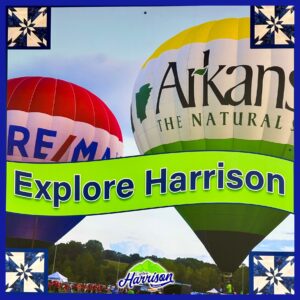
Explore Harrison is the sponsor of the Boone County Quilt Trail and to show their support of the trail, the Explore Harrison Balloon block is proudly displayed on the Explore Harrison building, located at 200 W Stephenson Ave, in Harrison. The Explore Harrison office hosts the Arkansas Hot Air Balloon State Championships every September. This event features balloons and spectators from all around the world. Established in 1996, the event has grown to include helicopters, kites, skydiving and more! The focal point of the block is the “Miss Arkansas” balloon piloted by Mike Mills and Austin Albers, owners of Buffalo Outdoor Center located just south of Harrison in Ponca. The fall season in the Ozarks is a wonderful time to visit and the Arkansas Hot Air Balloon State Championship is the perfect event to come to Harrison for some outdoor fun. Eat, Play, and Stay in Harrison, Arkansas!
Cindy Lou created a map that will help you plan your trip to see the trail in an efficient way. https://tinyurl.com/Boone-County-Quilt-Trail-Map
If you prefer a QR code.:

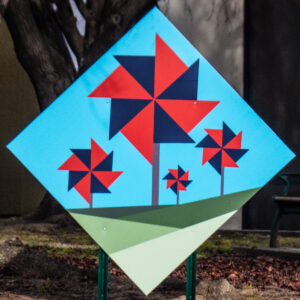
N. Main & E. Ridge St.
Harrison AR
#22-01, CASA TEMPORARILY UNAVAILABLE DUE TO STORM DAMAGE, quilt block is located in the Casa Garden of the Signature Bank building, on the corner of N Main & E Ridge streets in Harrison. The national CASA organization began in 1977 in Washington state. The local chapter, CASA of North Arkansas, was established in 2000. CASA recruits, trains and supports a diverse network of advocates who volunteer their time to ensure abused and neglected children find safe, permanent and loving homes. When a child, by no fault of their own, finds themselves in the judicial system they are often assigned a CASA volunteer. It’s that CASA volunteer who becomes a voice for that child. A CASA provides a report to the judge that often is heavily relied upon in order to judiciously rule in the best interest of that child. This work is immeasurable.
Volunteer – Donate – Get involved! www.casaofna.org 870-204-5489 Email: [email protected]
Special thanks to Kerrie Szabo for the block design and to Signature Bank for allowing us to place our quilt block in the CASA garden, at the Signature Bank building.
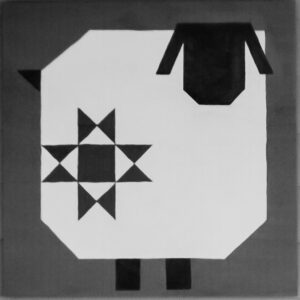
525 N. Cherry St.
Harrison AR
#22-02, The One Lost Sheep quilt block is located at 525 N. Cherry, Harrison. It was painted by Connie Rogers. So He spoke this parable to them, saying: “What man of you, having a hundred sheep, if he loses one of them, does not leave the ninety-nine in the wilderness, and go after the one which is lost until he finds it? And when he has found it, he lays it on his shoulders, rejoicing. And when he comes home, he calls together his friends and neighbors, saying to them, ‘Rejoice with me, for I have found my sheep which was lost!’ I say to you that likewise there will be more joy in heaven over one sinner who repents than over ninety-nine just persons who need no repentance. Just as a shepherd searches for a valuable lost sheep, so God seeks for us.
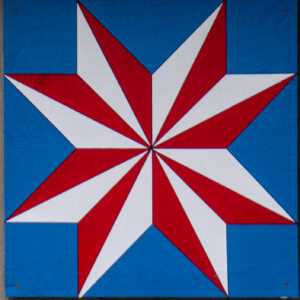
412 W. Bower St.
Harrison AR
#22-03, Mariners Star, is located on the north side of the house at 412 W Bower St. in Harrison. It was painted by Connie Rogers. The mariners star is just one of the most popular quilt blocks because of its symmetrical beauty it also represents the compass which has long been one of the most important navigational instruments to mariners. The invention of the compass made it possible to determine a heading when the sky was overcast or foggy, when landmarks were not visible. This enabled mariners to navigate safely far from land, increasing sea trade, and contributing to the Age of Discovery. This block hangs on our short-term rental, which we offer as a safe harbor for travelers in need of a temporary home away from home.
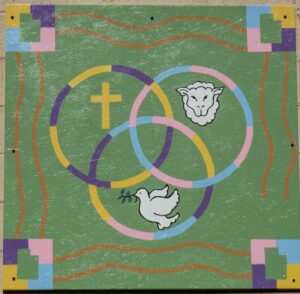
605 W. Central
Harrison AR
#22-04, Mountain Meadows quilt block is located at 605 W Central, on the side of the Boone County Heritage Museum’s Forest Building on the S. Maple St. side. The Boone County Heritage Museum‘s Forest Building houses artifacts and information about the Mountain Meadows Massacre. This terrible part of our area’s history ended on September 11, 1857 in Mountain Meadows, Utah. A wagon train of families traveling to California was attacked in a siege that lasted for five days. 120 men, women, and children were killed; seventeen children under the age of six were spared. The quilt patch has a wedding ring pattern to represent the unbroken and interlocking circle of a wedding ring and the family circle. The three rings stand for the three organizational descendant groups and the acronym of MMM. The first circle is for the 120 victims. The cross is the most common grave marker, representing Heaven, and was used because the attack was triggered by religious factions. Gold and purple colors were chosen because wedding rings are often gold, like the streets of Heaven, it will never tarnish like the family’s spirits. Purple is the color of honor, dignity, and ambition. The second ring has a lamb in the center to represent the seventeen innocent children that were spared. The colors of pink and blue are for girls and boys. The third ring is for the descendants. The dove is for peace and the branch can be a branch from a family tree and an olive branch of peace and reconciliation. The colors in the third ring are a combination of the other two rings, bringing all three groups back together. The green background is for a green meadow and the tan lines are wagon tracks that abruptly end because of the sudden halt of their fateful journey. The corners have the four colors again with a green Utah shape in the middle of each.
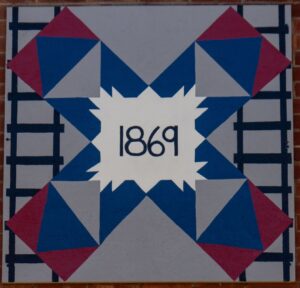
124 S. Cherry St.
Harrison AR
#22-05, Boone County quilt block is at the front of the building of the BOONE COUNTY HERITAGE MUSEUM, located at 124 S. Cherry St, in Harrison. The Boone County Heritage Museum has the honor of housing artifacts, records, and memories that showcase the rich heritage of Boone County. Located in the county seat of Harrison, the museum is nestled in a corner of the picturesque historic downtown area. The quilt block for the museum represents the many amazing aspects that make up Boone County. A prominent ”X” pattern is centered to represent a railroad crossing sign. There is a railroad track on either side of the patch. Boone County was made by taking a piece of two counties, one piece from its right border and one piece from the left border, and joining them to make the one county. The tracks also represent Missouri and North Arkansas which is the railroad line that was one of the main industries for local folks and a quick way to travel here. 1869 is placed in the middle because that was when Boone County became official. The bear claw pattern around the 1869 represents the natural beauty and abundant wildlife that has made Boone County a tourist destination and an exciting place to live. The colors of red, white and blue on the patch are shared with the United States and Arkansas State flags as we are a part of the bigger picture. There are squares with blue and gray touching back to back that reflect the civil war; the historical fact that this area saw small skirmishes with great loss and that families had both Union and Confederate representation.

202 S. Spring St.
Harrison AR
#22-06, The Burlsworth Block is located on the Brandon Burlsworth Youth Center sign facing 202 S Spring Street, Harrison. How many people do you know whose life story has been chronicled in a book and has also been the subject of a feature film? Brandon Burlsworth’s journey began right here in Harrison, Arkansas. When former Harrison Goblin, Brandon Burlsworth, arrived on the University of Arkansas campus in 1994, he had no money, no famous last name, and absolutely no Division 1 scholarship offers. Through his unbelievable work ethic and ceaseless determination, Brandon not only earned a scholarship, but became team captain, All-SEC 1997-1998, First Team All-SEC 1998, Football News First Team All-American in 1998, and the first All-American from the University of Arkansas in a decade. His success was not limited to the gridiron. He was also named to the All-SEC Academic Honor Roll every year from 1995-1998, he was also the first football player in the entire history of his university to earn a Masters degree “before” playing his last game. Brandon was selected by the Indianapolis Colts as the 63rd overall pick in the 1999 NFL draft. After minicamp, he was projected by his coaches to start as a rookie. Unfortunately, Brandon was tragically killed in a head-on automobile collision just eleven days after the draft. In 1999, the University of Arkansas created a scholarship endowment in Brandon’s name. Eighteen $5,000 academic scholarships, and one $10,000 Walk-On athletic scholarship are given out each year. The Brandon Burlsworth Foundation is also engaged in various charitable endeavors including the provision of free eye-care to thousands of underprivileged children. In 2010, the Burlsworth Trophy was created to honor the achievements and successes of the Walk-On athlete. It is presented annually to the Most Outstanding player who began his career as a Walk-On. This block was sponsored by Explore Harrison, designed by Connie Rogers, created by Kastle Graphics, LLC in Harrison, AR.
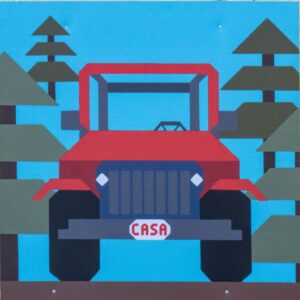
624 State Hwy 123
Harrison AR
#22-07, Jeepin’ for CASA – TEMPORARILY UNAVAILABLE PENDING RELOCATION. CASA of North Arkansas begins their annual “Jeepin’ for CASA” event from the South Campus of North Arkansas College (NAC) every April. Visit the CASA website below for more information. CASA recruits, trains and supports a diverse network of advocates who volunteer their time to ensure abused and neglected children find safe, permanent and loving homes. When a child, by no fault of their own, finds themselves in the judicial system they are often assigned a CASA volunteer. It’s that CASA volunteer who becomes a voice for that child. Volunteer – Donate – Get involved! www.casaofna.org 870-204-5489 Email: [email protected] Special thanks to North Arkansas College for allowing us to place our “Jeepin’ for CASA” quilt block on their South Campus.
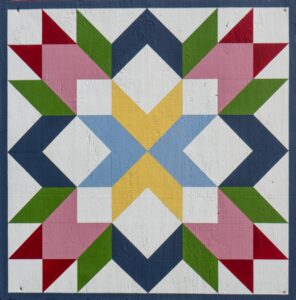
1787 Dees Cemetery Rd.
Bellefonte AR
#22-08, Garland’s Quilts are located at 1787 Dees Cemetery Road, Bellefonte. They were created by his daughter-in-law, Dana Johnson Brasel. Directions: US-412E/US-62/US- 65 S, turn Left at Stop light onto US-412E/US-62E (toward Yellville/Mountain Home), 1.7 miles turn L onto Keeter Loop, within 200 ft. turn left onto Brack Kimes Road E, after 0.3 miles turn right onto Dees Cemetery Road, after 0.2 miles you can find 1787 Dees Cemetery Road, at the corner of Keeter Loop.
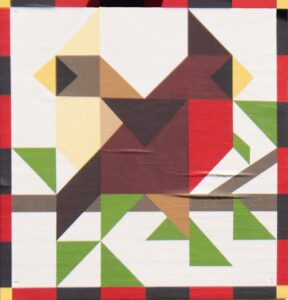
1787 Dees Cemetery Rd.
Bellefonte AR
Garland’s Cardinal is located on the garage facing Dees Cemetery Road, the second quilt, Katherine’s Quilt, is located around the corner to the right on Keeter Loop (before you head up the hill to #22-09). Garland’s barn quilts are in memory of Katherine. Garland and Katherine Brasel were married for over 55 years before breast cancer took her from the love of her life. They were always together and Garland misses her dearly. The colorful barn quilt made with Katherine’s favorite colors was hung on the old smokehouse that overlooks the memory garden he built shortly after she passed and planted Katherine’s favorite flowers that he watches bloom every season. The barn quilt on the garage depicting intertwined cardinals represents Garland and Katherine’s everlasting love for each other and is always a reminder to garland that Katherine is always close by.
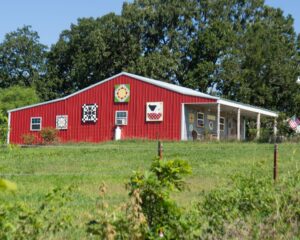
2288 Keeter Loop
Harrison AR
#22-09, Brasel’s Beauties, are located on the walls of two barns on either side of the Brasel home, at 2288 Keeter Loop, Harrison. With a total of 16 quilt blocks, this is a destination it itself! Directions: US-412E/US-62/US- 65 S, turn Left at Stop light onto US-412E/US-62E (toward Yellville/Mountain Home), 1.7 miles turn L onto Keeter Loop, within 200 ft. turn left onto Brack Kimes Road E, after 0.3 miles turn right onto Dees Cemetery Road, after 0.2 miles onto Keeter Loop (at this corner you will see #22-07 “Garland’s Quilts”), continue up the hill and you will see the first red barn to the left.
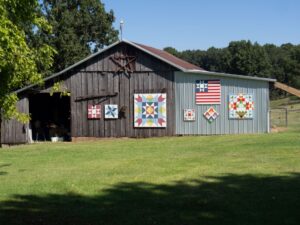
For extra scenery continue along Keeter Loop all the way back to US-412 E/US-62E. Owner Dana Brasel relates: During COVID and wanting something to pass the time, I came across barn quilts and loved their history. Barn quilts reminded me of the special times I had when I was younger and visiting my granny, who would hand stitch quilts together with whatever fabric pieces she had on hand and would make something beautiful.
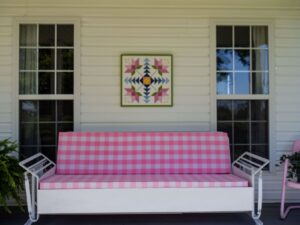
Searching the old barn and basement, much like my granny, I found old boards and paint for my first barn quilt, and when completed was hung on our rustic barn. I have painted numerous barn quilts since then and hopefully the quilts and the stories they tell will be enjoyed by others as much as painting them has brought me joy!
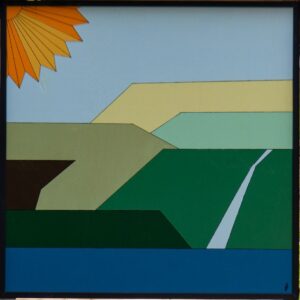
4927 Union Rd.
Harrison AR
#22-10, Ozarks Home, is a two-sided quilt block, located in the front yard of 4927 Union Road, Harrison. Directions: From Hwy 206 E, turn onto Union Road (north), go approximately ½ mile to 4927 Union Road (right on the first corner). Owner Cindy Lou Henley shares its story: We live in such a beautiful county in Arkansas, that I wanted to design quilt blocks that depicted our Ozarks Mountain area. This double-sided block is in an applique style. Ozarks Home #1 shows the landscape highlights of our area in the Ozarks. I have always loved the look of layered mountains and we have a view of them from our home, so I have included those in my quilt block. We are honored to have the Buffalo National River close by for scenery, floating, fishing and camping. This area is close to hundreds of waterfalls, including Hemmed-In-Hollow, the tallest waterfall between the Appalachian and Rocky Mountain ranges, and so many more. The Ozarks are filled with hiking trails and beautiful scenery, like Whitaker Point, Ozark Hiking Trail, Buffalo River Trail and more around every corner and hollow.
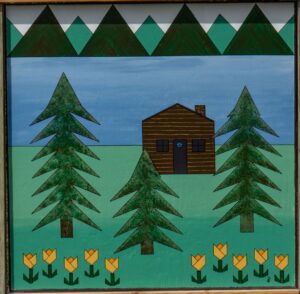
Ozarks Home #2 depicts the hidden areas and old homesteads around the area. Wandering down a backroad, you may find an abandoned home or the remnants of an old place: hidden in the woods, next to a stream, along an old rock wall, down a tree lined path. Some you can only find in the spring when the old-fashioned blooming flowers and bushes show where they used to be. Some of the stories of these places are known to the neighbors and some are lost to time or recorded in books of the area. This area has a rich history of people who have settled here, raised their families and passed down quilts they have sown with hard-working hands. I want to inspire everyone to get out and enjoy our Ozarks region and drive the Boone County Quilt Trail, see the countryside and be inspired by the beauty.
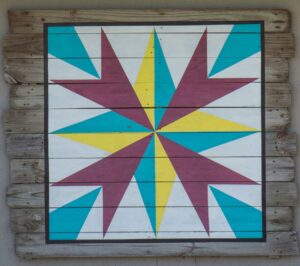
7380 Whispering Pine Rd.
Harrison AR
#22-11, Soil of my Soul quilt blocks are located at 7380 Whispering Pine Road, Harrison. From Highway 206, turn onto Whispering Pine Road, follow it 1.2 miles. Follow the sharp turn (do not continue straight onto Estes Dr.) .2 miles further will be 7380 on the right. The blocks were created by Dan and Kathy Morrison. He shares its story: Kathy and I were married in Bella Vista, AR in May 1996 and 2 weeks later we moved out west to Montana for my job at Yellowstone Park. We were there for 6 1/2 wonderful years. Then 2 1/2 years we moved for the National Wildlife Service on the coast of Texas. Next we moved to Custer in the Black Hills of South Dakota to work at Jewel Cave. While we were there, Kathy worked at Crazy Horse Memorial. We were there from 2005 till 2011. During that time we met many friends, one of them being Sara, who introduced us to the idea of barn quilts. Sara now has a group of friends there that make and encourage the display of them throughout that area. We retired in 2011 and moved to upper Maine to be close to grandkids and later we moved to Massachusetts near Brimfield, known as the antique place. We finally decided to move back to Arkansas, the Soil of my Soul.
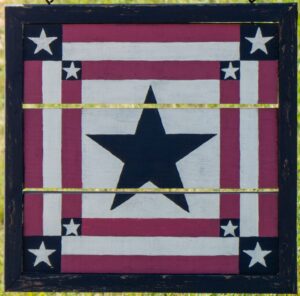
Kathy remembered how much we liked the idea of barn quilts and we made our first one in 2019. Being a Vietnam veteran, we fly a US flag, so we decided to make a small flag inspired, two-sided quilt block for our mailbox.
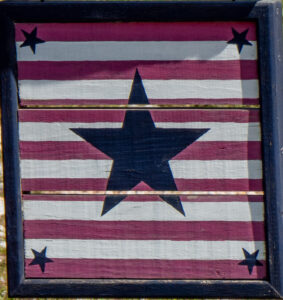
Kathy is the creative idea person, and I make it happen. We have another quilt block hung on our outbuilding; we painted this one on some old fence wood. We work well together and are so excited to be part of the quilt trail. We hope to gradually add more.
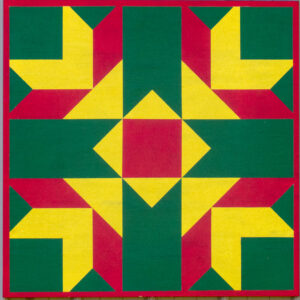
7580 Whispering Pine Rd.
Harrison AR
#22-12, Hen and Chicks quilt block is located at 7580 Whispering Pine Rd. It was created by Mitzy Cox’s husband. You will see the quilt block on the garage building on the right. My husband and I love our beautiful state of Arkansas, especially the Harrison area. In our travels of Northern Arkansas and into Missouri over the last few years we started noticing these beautiful painted wooden barn squares. At the time we didn’t realize they were replicas of old quilt squares. My husband loves working with wood and with a little encouragement from me I got my first wooden quilt square. It is called “Hen and Chicks”. I enjoy driving down our dirt road to have this beautiful art greet me each time.
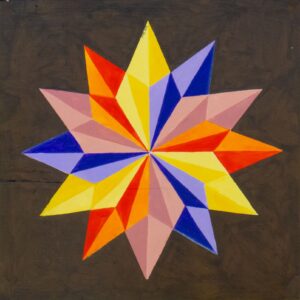
7214 Prairie View Rd.
Harrison AR
#22-13, Sunburst quilt block is located at 7214 Prairie View Road, Harrison. From Highway 206 turn ono Prairie View Rd. Drive .5 miles. The quilt block is located on the fence, next to the mailbox for 7214. This quilt block was created by Patsy Hipp. Patsy loved quilt blocks. So, naturally, she joined her church’s quilting group, thinking that could be her new hobby. Later she decided quilting was not her cup of tea so she decided to try painting one and a new hobby began. She paints them for herself. She paints them by commission. She has also sold them in a local retail setting. Patsy continues her love for quilt blocks which she enjoys displaying at her home. Her quilt blocks are sprinkled across Boone county and beyond. Patsy and Gary Hipp are life-long residents of Boone County. They have called this place home for 30 years.
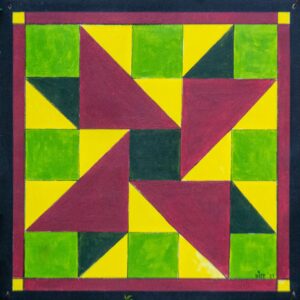
174 Harness Rd W.
Harrison AR
#22-14, Pinwheel In The Sun quilt block is located at 174 Harness Road W, Harrison. It is located on the garden fence. It was created by Patsy Hipp. Directions: From Harrison, drive Hwy 7 S for 1.5 miles, turn right onto Harness Road W. 174 Harness Road W is the 7th house on the right. The quilt block is on the garden fence past the house. I picked this quilt pattern because I was drawn to the colors and design. My family moved here in December 1972. When we told people where we lived, they would often ask if that was near the old Baines School House site. We soon found out that, indeed we did live within view of that site. You can still see the rocks that surround the old well at the school house. It’s on the southwest corner of Hwy. 7 and Harness Rd. George Washington Baines was born December 29, 1809 in Chowan county in North Carolina. The school was named after him. He was licensed to preach in the Baptist church before he and his family moved to Carroll County Arkansas. This area later became part of Boone County. He started three churches in the area and also taught school. He was elected to the Arkansas General Assembly in 1842. He and his family later moved to Texas where he was president of Baylor University for a time and died in 1882. His great-grandson was Lyndon Baines Johnson who became our nation’s 36th president.
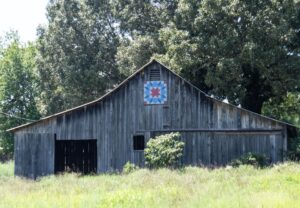
3722A Hwy 7 S.
Harrison AR
#22-15, Carpenter’s Wheel is located on an old barn 3722A Hwy 7 S., Harrison, in the pasture on the west side of the highway. It was created by Joyce Holt. Directions: Hwy 7 S, 3 miles from Brandon Burlsworth Youth Center in Harrison. Look to the right, the barn is right after a two-story white house (3722 Hwy 7 S). This barn quilt was designed and painted by Joyce Conner Holt. It’s displayed on the barn situated on the family’s farm. The barn was built in the 1940’s by J.B. Holt, who was a long-time Boone County Deputy Sheriff. He was the grandfather to Doug Holt, the painter’s husband. The block design was inspired by a hand-made quilt, given to Joyce by her grandmother. Joyce proudly continues the family quilting tradition to this day.
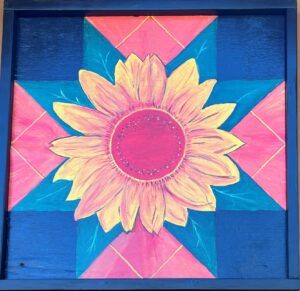
3937 Hwy 43
Harrison AR
#22-16, Sunflower quilt block is located at 3937 Hwy 43, Harrison. It was created by Susan Stills. Directions: From Brandon Burlsworth Youth Center in Harrison, drive 0.8 mile and drive straight onto AR-43 S/Wilson Avenue. Continue on AR-43 for 2.9 miles. 3937 AR-43 S is on the right, you will see a Kozy Korner sign and Sasquatch next to the driveway. The quilt block is located on the peak of the garage. Susan shares: I was inspired to create this quilt block because of my love of quilts. I have always loved sunflowers because they are sunny and bright. When the war broke out between Russia and Ukraine, I knew I had to paint this pattern featuring a sunflower, because of its significance to the Ukrainian people. The sunflower is the national flower of Ukraine. They prominently display them in festive celebrations, as decorations in their apparel, wreaths and headdresses. After the Chernobyl nuclear power plant accident in 1986, they planted sunflowers in that devastated area. Ukrainians view the vibrant flower as a symbol of peace and resilience. I imagine the symbol has never been closer to their hearts in this current time of war. This quilt block hangs here today, in support of them.
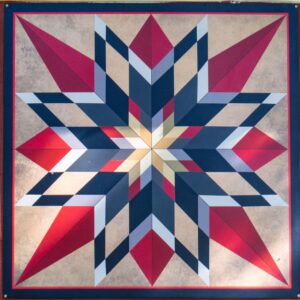
8757 Hwy 43 S.
Harrison AR
#22-17, Amish Star quilt block is located at 4R Farms, 8757 Hwy 43 S, Harrison, AR (toward Compton). It is located on the red milk barn across the pasture from the driveway. It was created by JoAnne Rowland. Directions: Follow Hwy 43 S (5.1 miles from #22-16 3937 AR-43), up Gaither Mountain (be sure to stop at the lookout at the top to see a beautiful view of the valley), continue to 8757 Hwy 43 S, 4 R Farms, on the right. JoAnne shares: The Amish Star block on our milk barn represents a family that is rich in agricultural history. The farm where our block is located was purchased in the mid-1950s by JoAnne’s maternal grandparents. They packed their belongings and three small children and moved from Michigan to start a dairy farm in Arkansas. The farm was nothing more than a few leftover fruit trees from the previous owner and a two-room concrete building. Lots of hard work went into clearing the land, building the barns, the silo, and a house. All the work was done by my grandfather. They operated a Grade A dairy and milked registered Holstein cows. I spent many hours working alongside my grandfather on the dairy, as well as later when he kept beef cattle and grew hay and silage. My grandparents and I did a lot of talking about how I would buy the farm someday. Little did I know that I really would end up marrying someone who loved to farm as much as me. Fast forward to 2001. My husband and I bought the farm and moved my grandparents to a little house on a hill that overlooked the farm. I left my teaching job and got to live my dream of being a farmer. Along with our two children, we milked our own herd of registered Holsteins for 15 years until we were the only dairy left in Boone County. The high cost of transporting milk to the processing plant helped us to decide to switch to beef. Now we raise red angus and black angus cattle and katahdin sheep. Quarter horses and barnyard chickens keep us busy too. My grandparents were recognized as the Boone County Farm Family of the year in 1965 and the Senior Farmer award in the early 2000s. My family and I were awarded the Boone County Farm Family of the Year award in 2014. It is an extra-special honor to us since we won the same award 49 years after my grandparents. We worked the same farm and were doing the same type of farming as they did when they won the award. The unique thing about the building where I have my block hanging is that it used to be where our large milk tank was housed and used. Anyone who knows anything about dairying knows that a lot of time is spent in the dairy barn. I have converted the tank room into a classroom where I teach sewing and quilting classes. I love the opportunity to share my farm with others through sewing.
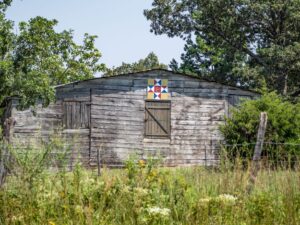
9167 Hwy 43 S.
Harrison AR
#22-18, Eight Pointed J Star quilt block is located on an old barn at 9167 Hwy 43 S., Harrison. The quilt block was created by Paulette Jech. Directions: Follow Hwy 43 S (2 miles from #22-17 8757 AR-43 S) on the left side of the highway. The Eight Pointed J Star hangs on an old barn at 9167 Hwy. 43 South, Harrison, AR on the property of Jeff & Paulette Jech. Paulette painted the 3’x3’ quilt block on plywood that Jeff cut. She also painted a mandala on the north side of the barn to add to its charm. The mandala is best seen by stopping by the gate.

The quilt block is on the front of the barn so continue a bit down the highway to see it. When the Jechs purchased the property which is about 3 miles from their house, the barn was in very sad shape. Paulette thought the quilt block would help the old barn look happier. They have made many repairs on the old barn and are not done yet. Nothing on the barn is level, square, or perfect, but they love it anyway. No one seems to know when the barn was built, but the “old timers” said it’s always been there. Whoever built it had used rough oak boards and other materials as it was patched over the years. Paulette thought the name, The Patchwork Barn, would fit it very well. Quilts have been part of their families for generations. Most quilts were made out of necessity using any scraps of any cloth available. You could often look at a quilt and find scraps of a dress you once wore. Paulette’s Grandma Keeton taught her how to hand piece quilt blocks when she was 11. Later her grandma taught her how to hand quilt on frames which were hung from the living room ceiling. When they finished quilting for the day, the frames were rolled then pulled by ropes back up to the ceiling out of the way. I think Grandma Keeton would really get a kick out of seeing quilt blocks on barns nowadays!
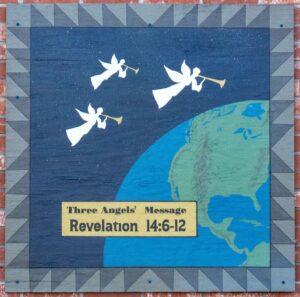
4897 Hwy 392 W.
Harrison AR
#22-19, Three Angel’s Message quilt block is located on a building behind the Seventh Day Adventist Church, at 4897 Hwy 392 W., Harrison. Designed and painted by Connie Rogers, Ruthie Hintz and Wei Chung. The mission of the Seventh-Day Adventist church is to make disciples of Jesus Christ, who live as His loving witnesses and proclaim to all people the everlasting gospel of the Three Angels’ Messages, in preparation for His soon return. (Matthew 28:18-20, Acts 1:8, Revelation 14:6-12) The Seventh-Day Adventist church was organized in 1863. It has 21.9 million members in 212 of the 235 countries recognized by the United Nations. Locally, the first church in Harrison was established in 1888. In 1978 the current property was purchased and the church was built soon after. The school began in September of 1973. Adventists have the second largest parochial school system in the world, with more than 7,500 schools in nearly 150 countries, serving 1.5 million students.
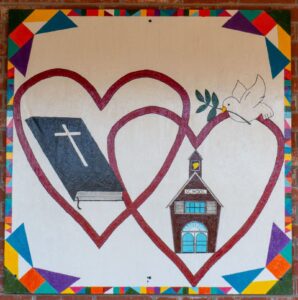
4897 Hwy 392 W.
Harrison AR
#22-20, Jesus and Academics quilt block is located on the School building of the Seventh-Day Adventist Church, 4897 Hwy 392 W, Harrison. Designed by Tim & Teresa Smith. Painted by Tammi Bulla…with a little help from the students! Jesus and Academics represents the mission of the school to provide a Christian education to students in grades K-8. The dove symbolizes the Holy Spirit who helps us on our journey with Christ Jesus. Two hearts entwined show Jesus’ love connecting us to Him. Red reminds us that one drop of His blood can save us. White represents the purity of each person’s heart who accepts Jesus as their Savior. Yellow glows with life from the Son of God. Green symbolizes resurrection and a new life in Jesus Christ. Purple tells of Christ’s royalty and status as our High Priest. Turquoise represents sanctification and the healing of the nations.
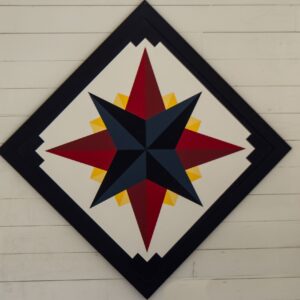
10872 Hwy 392 W.
Harrison AR
22-21, Mariners Compass quilt block is located on the front porch of the Country Corner Quilt Shop, 10872 Highway 392 W, Harrison AR. One of the Trail’s treasured gems can be found at the Country Corner Quilt Shop, located at 10872 Highway 392 W, Harrison, AR 72601. Larry and Alma Collins first built a small one room shop in 1986 to sell finished quilts at this historic crossroads. The site has a long history, at one time being a stagecoach stop, a motel, and a rabbit farm. The train once ran directly behind the shop to the Batavia tomato canneries. Joyce Miller, bought the shop from her parents in 1998, and has expanded its services to include computerized quilting, quilting machine sales and services, and a broad range of fabric and sewing notions. And of course, we still sell finished quilts to the public. Country Corner Quilt Shop has been privileged to have a diverse group of talented individuals on its staff over the years. Our 37 years of business would not have been possible without our outstanding staff and our wonderful customers from all over the United States. Our quilt block, “Mariners Compass” illustrates their passion and creativity. Mounted on the left side of the building facing the parking area it directs our visitors. Created by a talented local artist, the barn quilt tells a story of craftsmanship passed down through generations and the enduring spirit of the Ozarks. As you stand before this vibrant piece of art, take a moment to connect with the hands and hearts that crafted it. Four generations of the family that built and still owns this business have quilted here.
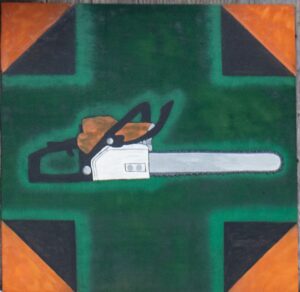
122 E. Main St.
Alpena AR
#22-22, Stihl Running is located on the upper peak of the Alpena Chainsaw Art business, at 122 E. Main Street in Alpena. Alpena Pass was founded in 1908 on top of a graveyard, shortly after the Missouri and North Arkansas Railroad was built through Boone County. The cemetery was relocated and buildings were moved from Carrollton, a nearby town in decline, that was the county seat at that time. This building has housed a vast array of businesses including an auto part maker shop, a gas station, an auto repair shop, a restaurant and presently a chainsaw carving business.
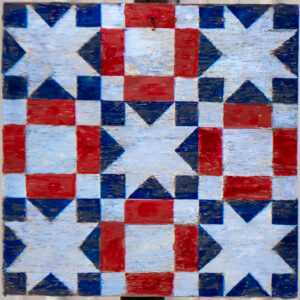
6445 Doolittle Dr.
Omaha AR
#22-23, Star is TEMPORARILY UNAVAILABLE DUE TO REPAIRS located at 6445 Doolittle Drive, Omaha. Directions: From Harrison – U.S. Hwy 65 N from the Arkansas Visitor Center for 9 miles, turn L onto Burlington Loop, and then Right onto first road, Doolittle Drive. The quilt block will be at the 2nd house on the left. Pat Williamson shares: I so enjoyed doing this Star block. It reminds me of my great grandmother, Opal Beeler, who loved quilting, and my grandmother, Nola Roberts. My grandmother, Nola, loved doing the different star quilts. She sewed them together with her singer treadle machines and hand quilted them in frames she hung from the ceiling in the living room. I was so blessed to still have a quilt from both of them.
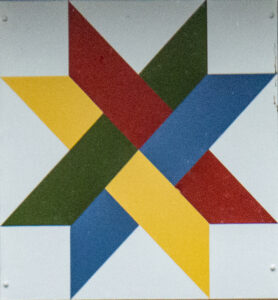
1131 Mallard Dr.
Diamond City AR
#22-24, Woven Ribbon/Woven Star quilt block is located on the garage wall of 1131 Mallard Drive, Diamond City. Directions: In Diamond City, from AR-7 N, turn left onto Barr St, then turn right onto Mallard Drive. 1131 Mallard Drive will be on the right. Diamond City and Bull Shoals Lake have been dear to our hearts since 1970. We truly love the area and are so pleased to be able to have a home in Diamond City. I’ve always wanted a barn quilt – but have no barn. So, one day I told my husband that I thought we could put one on the garage and enjoy it. So, for Christmas in 2005 I asked him for marine grade plywood so that I could make my wish come true. I chose this very simple pattern, Woven Ribbon or Woven Star, and enjoyed painting it. Every time that we pull into the driveway it makes me smile. I hope it makes you smile, as well. I am excited to be part of the Boone County Quilt Trail!
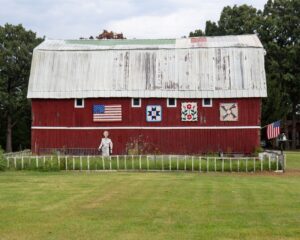
6619 White Fence Dr.
Bergman AR
#22-25, 4 Red Barn Quilts are located at 6619 White Fence Drive in Bergman. Directions — From Hwy #7 North in Bergman, turn onto Zinc Rd. at the Dollar Store. It’s 8/10 mile to White Fence Drive. Red Barn is on the left. There is a parking spot behind the mail boxes. While traveling throughout the country, I have loved seeing barn quilts and paintings displayed on barns and buildings. Each trip to Kansas to visit family, I notice more and more barn quilts from the road and on buildings in small towns. Our big red barn seemed so empty, so we began to make a few to decorate it. The 4 Quilt Blocks are:
- Our Flag – Built by John Rego. Each star was individually cut and mounted on the blue background. It was painted by Betty Rego and first displayed in 2019.
- Star with “R” Initial for Rego.
- Ohio Rose – We met and were married in Ohio. The flowers and leaves were cut out individually by John Rego and mounted on the background.
- God and Country – Symbolizing our country’s Christian heritage. To God be the Glory. Bless the USA. Painted by Betty.
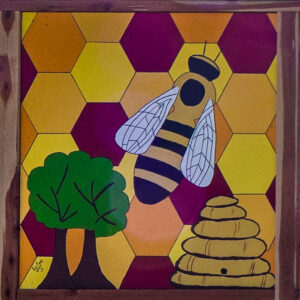
3625 Carole Lane
Harrison AR
#22-26, Two Trees Queen Bee, can be found amongst the honey bee hives in the front yard apiary of Clint and Leslie Nichols residence (Two Trees Farm) located at 3625 Carole Lane in Harrison AR, just 4 miles from North Arkansas College South campus, as the crow flies! NOTE: Please do NOT exit your vehicle; there are active bees on the property.
DIRECTIONS: Heading S on Union Road from Harrison, turn right onto Carole Lane. Heading N on Union Road from Hwy 206, turn left onto Carole Lane. 3625 Carole Lane is the first house on the left side of the road.
This quilt block represents one of the most important, and efficient pollinators on Earth – the Honey Bee (Apis Mellifera). The bee in focus is the colony’s QUEEN. She is depicted here with an abdomen slightly longer than that of her daughters, the worker bees. My name is Leslie Nichols, the quilt’s creator, and hobbyist beekeeper. In 2014, I had seen a PBS Television vignette on backyard beekeeping. It seemed easy enough and like a good way to help support our EcoSystem. I started with two nucleus colonies of honey bees the following spring. Yes! Bee stings are part of the beekeeping gig! But a decade later I maintain around 20 colonies of honey bees. Most people will ask me about honey, and who doesn’t love honey! The quilt brings attention to the red, yellow and orange pollen in the hexagon cells. While worker bees forage blooms to collect pollen and nectar; they do not see the color red. The red pollen seen throughout the quilt is collected from Purple Deadnettle in the early spring. Honey bees alone pollinate 80 percent of all flowering plants, including more than 130 types of fruits and vegetables (www.farmers.gov 2020). The Skep, or beehive, on the quilt’s lower right corner was used for centuries to ‘keep’ honey bees. Skeps were typically made of straw, dried grass, and even cane. However, they were fragile and didn’t hold up well in the weather. The hives I use in my apiary are Langstroth hives which are made of pine; and with a good coat of paint, will last for years. And finally, in the lower left hand corner of the quilt, are two trees. Clint and I live on 24 acres located in the Krooked Kreek Valley of Boone County. Several years ago we built our home near those two trees located in the backyard pasture. With a panoramic south facing view we can clearly see Gaither Mountain, and the mountains beyond. It is our greatest hope that this quilt will help bring attention to one of our most important pollinators – The Honey Bee.
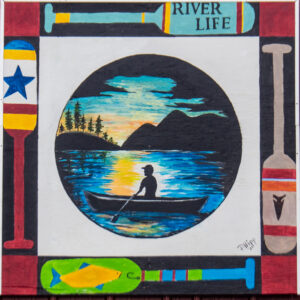
2729 Hwy 206 E.
Harrison AR
#22-27, River Life, block is located on the shop building at 2729 Hwy 206 E. Harrison AR. NOTE: At the request of the owner, it is permissible to turn around in the driveway but please DO NOT exit your vehicle when viewing this barn quilt. Mike McCutcheon, the owner, was raised on the Buffalo River. In the 1960’s, he remembers many times when he and his sister Patsy, and their parents, would load up and float the Buffalo. He has maintained a lifelong love of the river and vows to spend 100 miles on the river every year. The Buffalo River became the first national river in the United States on March 1, 1972. The Buffalo River is a free-flowing river, fed by tributaries and springs and beautiful spill-offs cascading down limestone bluffs throughout the mountainous region. The 150 mile long river runs through Newton, Searcy, Marion and Baxter counties. It originates in the Boston Mountains, flowing generally from east to west and eventually into the White River. The river has a healthy eco-system with a vast array of wildlife, fish and vegetation. Jimmy Driftwood, native son and songwriter said the Buffalo River was, “Arkansas’s gift to the nation, America’s gift to the world.” Notably, In his early life, Jimmy Driftwood taught school in Snowball, AR and Mike McCutcheon’s father was one of his students. Whether or not to dam the river has been a hotly debated issue with passionate people on both sides. On one side, those interested in the hydroelectric potential of the river and on the other side, those vehemently opposed. In the face of great local opposition, the group proposing redesignation backed off its plans. Arkansas Farm Bureau announced on December 1, 2023 the official adoption of a policy opposing any potential redesignation. The Buffalo River is one of the leading tourist destinations in Arkansas. Official park visitors average over 800,000 per year. Source: encyclopediaofarkansas.net. The barn quilt was designed and painted by the owner’s sister, Patsy Hipp.
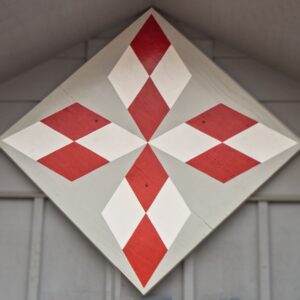
135 Hwy 14 N.
Lead Hill AR
#22-28, Arkansas Travelers, is located at the Heavenly Beauty Salon, 135 Hwy 14 N, Lead Hill, AR. LET’S PLAY BALL! The All-American past-time especially for the small town of Lead Hill, AR with a school district full of team spirit. As far as I have been able to obtain past history, the local gentlemen played ball for the Jaycees in Harrison AR. In 1953-1954. In 1961, John Clary of Lead Hill was awarded the “All-American League Player “ for the National Baseball Congress. Here’s some background on the home team’s winning years. Lead Hill is a small town in northern Arkansas with a rich history, including some links to baseball. According to the web search results, here are some facts about Lead Hill and its baseball history: Originally a mining town, Lead Hill was named after the lead deposits found in the area. The town was relocated due to the creation of Bull Shoals Lake in the 1950’s. Lead Hill has a high school baseball team, the Lead Hill Tigers, who compete in the Arkansas Activities Association (AAA) 1A classification 2. The team colors are red and white and their mascot is, of course, a tiger. Lead Hill has hosted several summer baseball leagues over the years, such as the Lead Hill Summer Baseball League, the Lead Hill Babe Ruth League, and the Lead Hill American Legion League. These leagues were open to players of various ages and skill levels and provided an opportunity for the community to enjoy the sport of baseball. Lead Hill has also produced some notable baseball players, such as Jim Golden, who was born in Lead Hill in 1936 and played as a pitcher for the Los Angeles Dodgers and the Houston Colt .45s in the 1960s. Another famous player from Lead Hill is John Mayberry Jr., who was born in 1983 and played as an outfielder for several MLB teams, including the Philadelphia Phillies, the Toronto Blue Jays, and the New York Mets. Coach Heath Richardson coached for many years including several teams that advanced to state tournaments and in 1999 finished state runner up. During the years of 1990-2010 the team had 15 years of district championships and also trips to the state tournaments. In 2016 the Lead Hill summer league was awarded the John Paul Hammerschmidt award. Our grandson, who visited during the summer, pitched the winning game. This was my inspiration to join the Arkansas Quilt Trail and give recognition to the coaches and team players dedicating their summer to “play ball”. My husband and I are thankful to Lead Hill School for giving our grandson the opportunity and experience of playing ball, which taught him the art of teamwork and pride of sportsmanship. The Block Board “Arkansas Travelers” is a small tribute for all to see the joy, teamwork and pride in the small town of Lead Hill, Arkansas. “ GO LEAD HILL TIGERS!! I am also a proud quilter and a member of Stitch n Time Quilt Guild of Lead Hill/Diamond City. Anne Fournier.
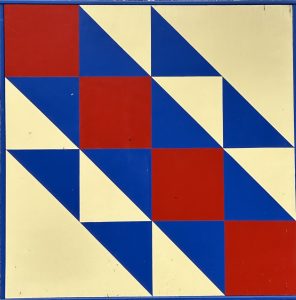
8756 Hwy 43 S.
Harrison AR
#22-29, Stairway to Heaven, is located at 8756 Hwy 43 S., Harrison AR. Owner Anne Brisco shares the story. As I prepared for retirement from Arkansas Health Department, I knew I had to do something to stay busy. I have sewn for many years but in this stage of my life, I decided I wanted to make quilts. I joined the Quilt of the Month Club at Country Corner Quilt Shop. I enjoy browsing quilt designs on TV and in printed publications. I discovered that I prefer quilts with simple patterns rather than those with more intricate patterns. I have a long arm quilting machine which allows me to not only piece the quilts but complete the entire quilting process from start to finish. When I give someone a quilt, I ask them to use the quilt instead of storing it away. I chose this block to represent my quilting journey. I am active in the Extension Home Makers Club, and I especially enjoy the gatherings focused on quilting. Now each day I’m climbing that stairway to heaven.
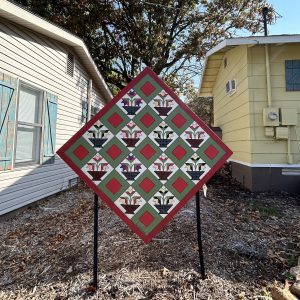
491 Union Rd.
Harrison AR
#22-30, Momma’s Hands, is at 491 Union Rd., Harrison AR. Alisa Morris owns this quilt block. Momma’s Hands represents a quilt made by her mother, Audrey Hensley, of Harrison. The quilt was given to her six years ago. Alisa chose this design for her mother to make the quilt because she loved the colors and the flowers. This pattern is commonly called “Tulips in a Vase” and its origin can be traced back to the 17th century, when the Netherlands popularized tulips around the world. Tulips were a popular motif for quilt makers of all ethnicities, and many variations of the tulip design were used in appliqued quilts in the 19th century. This block was painted by Joyce Bryant of Arkansas.
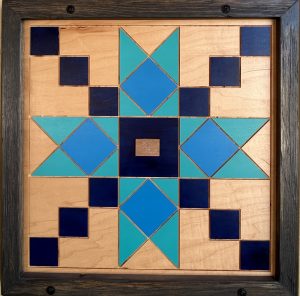
8999 Hwy 7 S.
Harrison AR
#22-31, The Quilted Cow, is located at 8999 Hwy 7 S, Harrison AR at the Daisy Queen. The restaurant has been serving our guests since 1969. We are a family friendly dining restaurant with homemade daily specials as well as your traditional diner foods. Daisy Queen was just named in the “ TOP 10 Burgers” by the Arkansas Beef Counsel. We are motorcycle friendly. We have shakes, malts, sundaes, ice cream cones, banana splits and a variety of homemade desserts such as chocolate and coconut pies, cakes and cobblers. This block was designed by Susie Jackson, owner of the Quilted Cow – Gulf Shores Alabama. Susie is originally from the Ozarks and is now pursuing her lifelong dream by providing quilters everything they need to keep the art of quilting alive for generations to come! Check out her Facebook page “The Quilted Cow Gulf Shores” You can also come inside the Daisy Queen and ask her niece, Kayla, for one of her business cards. Have a homemade meal or slice of pie while you’re there! Also check out our Facebook page “Daisy Queen – 7 South” to view our full menu. Hope to see y’all soon!
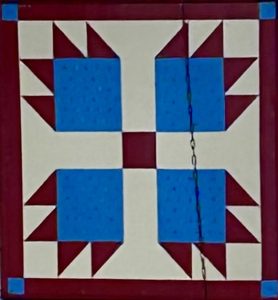
7885 Hilltop Rd.,
Harrison AR
#22-32, Bear Paw, is at 7885 Hilltop Road, Harrison on Gaither Mountain. Head south on Hwy. 43 S from Harrison, approximately 11 miles. Turn right onto Hilltop Road, and you’ll see the Hilltop Community Building on the left. The quilt block is located on the historical structure that was once called The Mission School Church. Over the years it has been used as a Grange Hall, by various churches, and 4-H Clubs. It was built in 1916. Today this charming old building serves as the Hilltop Community Building. It continues to be used for a variety of community activities. The Hilltop Ladies Auxiliary meet here weekly to create their beautiful hand quilted quilts which will be auctioned off each fall to raise money for the Hilltop Volunteer Fire Dept. The Hilltop Ladies Auxiliary have been making quilts since 1995. They chose the Bear Paw pattern and colors for the quilt block. The block was painted by Paulette Jech and her husband, Jeff assisted by cutting the 4’ x 4’ block and frame. Paulette & Jeff also created the hand painted sign for the community building.
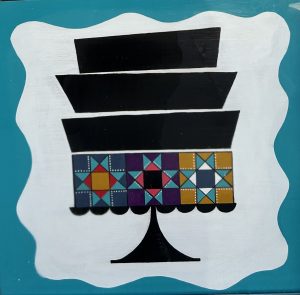
218 W. Stephenson
Harrison AR
#22-33, Piece of Cake, is located at 218 W Stephenson, Harrison AR at The Cake Shop. It is owned by Robin Reeves. Who doesn’t want a piece of cake? The artists at The Cake Shop bake and create beautiful custom cakes, cookies, gourmet cookies, sandwich cookies, pies, cake balls and more. Call ahead for a custom order or walk right in to choose a tasty treat from our case! We’d love to serve you!
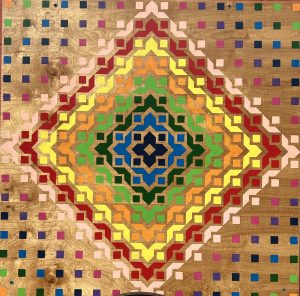
3220 Hwy 62/65 N.
Harrison AR
#22-34, Trailside, is at 3220 Hwy 62/65 N., Harrison AR at Lovejoy’s Collectibles. The owners are Keith and Kristie Lovejoy. This block is owned by Kristie & Keith Lovejoy. Kristie was inspired by the beauty of this block design. She is a quilter herself. From her childhood, she cut out material for her granny, Dorothy Bennett, who was also a quilt-maker. Kristie is a native Arkansan and Keith is originally from Lisbon, Ohio (notably about 100 miles from the very first quilt block which was located in Oberlin OH. About their business, Lovejoy’s Collectibles, Kristie and Keith both had 9-5 jobs and aspired to do something different. They had experience with booth rental businesses through Keith’s parents and seized upon this opportunity in 2012. The Lovejoy’s have a large space (aprox 13,000 ft) with an excellent layout. The creative displays enhance the shopping experience. You’ll find an extensive array of antiques, vintage and collectible items, offered by approximately 40 vendors, each of which bring their own personalized flair. Kristie says the customers are their favorite part of the business. Come with some time to browse and enjoy!
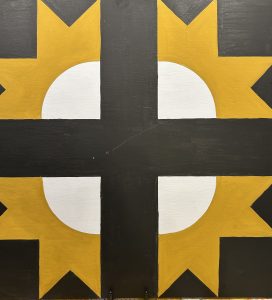
216 W. Stephenson
Harrison AR
#22-35, Cross and Crowns, is at 216 W Stephenson, Harrison AR. The owner is Tania Copeland. It’s located at the Missing Piece Boutique where it is our mission to encourage and empower all women to feel beautiful in their own skin. To support, encourage and uplift all women. Knowing that women have a lot on their plate already, we strive to take some of the stress out of their shopping experience by offering the Boutique experience, WITHOUT the Boutique price. It is also our mission to give back to our community more than we take away from it. To always be willing to lend a hand up to anyone in need and to always make time for conversation and remember that without the community there would be no Missing Piece Boutique. We hope that we can inspire others to straighten each other’s crowns without letting anyone else know they needed straightening. There is so much negativity in the world and we can all use a little help sometimes. I hope you all have a wonderful day and an even better tomorrow. In a world where you can be anything, be nice to each other. It’s not hard. We can do it! missingpieceboutique.com
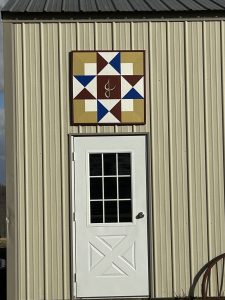
12047 Hwy 43 South
Harrison AR
#22-36, J Star II, is at 12047 Hwy 43 South, Harrison, AR. The J Star II quilt block is located on a metal shop building at 12047 Hwy. 43 South, Harrison. Directions: Follow Hwy. 43 South up on Gaither Mountain (approx. 3 miles south of quilt block #22-18). The J Star II was painted by Paulette Jech and the woodwork was done by her husband, Jeff. The quilt block is seen best by driving past their mailbox and looking to the left through an opening in the trees. The Jechs also have property about 3 miles north of their home which has a very similar quilt block #22-18. Paulette painted them nearly alike so that people might know that both properties are theirs although they are not physically connected. Paulette has also painted a floral mural on the back (north side) of a small shed next to their home. She hopes that it might bring a smile to someone’s face as they drive by. It can be viewed by pulling into Pete Sims Lane (which also serves as the driveway to the Hilltop Community Bible Church). This is across the highway from the Jechs.
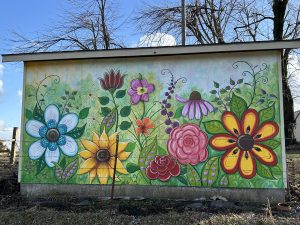
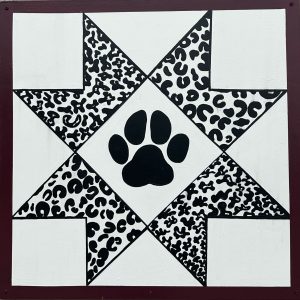
407 Hwy 62
Alpena AR
#22-37, Spotted Pride is at 407 Hwy 62, Alpena AR. This block represents Alpena School District of Alpena, Arkansas. Their colors are maroon, white and black. The Alpena Leopard Art Quilt Square features black leopard spots on a white background surrounded by a maroon border. This block was designed and painted by the students.
The Alpena Leopard mascot is a beautiful animal with fur color varying in individual animals from pale yellow ochre to dark golden with dark spot rosettes.
The leopard is featured in art and mythology, and is considered by many cultures to be a symbol or motif of royalty and leadership. As the mascot of Alpena, the Alpena Leopard symbolizes a seeker of knowledge and truth.
This is exciting! So wanting to plan and put at least one on our property!
Susan, if you’ve not already checked in with the Boone County Quilt Trail coordinator, please look up Connie Rogers on our contact list here. https://arkansasquilttrails.com/contacts/
She will be glad to hear of your interest.